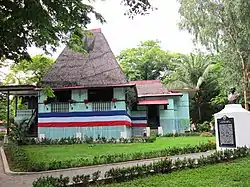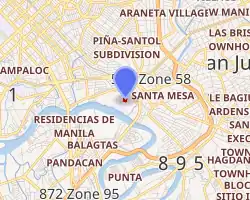Mabini Shrine (Manila)
The Apolinario Mabini Shrine (Filipino: Dambanang Apolinario Mabini) is a historic site in Santa Mesa, Manila, Philippines. It is noted for being the residence of Filipino military leader Apolinario Mabini who figured in the Philippine Revolution. Originally situated along the Nagtahan River, the strucure was moved to the Polytechnic University of the Philippines main campus in Santa Mesa, Manila in the mid-2000s.
| Mabini Shrine | |
|---|---|
Dambanang Mabini | |
 | |
 | |
| General information | |
| Status | Completed |
| Current tenants | Museo ni Apolinario Mabini |
| Named for | Apolinario Mabini |
| Technical details | |
| Material | Bamboo, nipa |
| Renovating team | |
| Architect | Juan Nakpil (1960s) |
History
As house of Apolinario Mabini
The bamboo-and-nipa house which would later became known as the Mabini Shrine was owned by Cecilio del Rosario and Maxima Castañeda. The del Rosarios became related by affinity to Apolinario Mabini, a significant figure of the Philippine Revolution, after Mabini's younger brother married a woman in the del Rosario family. The original house used to be located across the river in Nagtahan, Pandacan, Manila. Apolinario Mabini first lived in this house in 1888, the year he entered law school at the University of Santo Tomas. He continued to live there through most of his adulthood.[1][2] On May 13, 1903, Mabini died of cholera at the age of 39 in this house.[3]
Relocation

The house was moved to the south bank of the Nagtahan River in 1960, within the Presidential Security Group Compound in Malacañang Park in order to give way for the widening of Nagtahan Bridge (now Mabini Bridge). It was then restored under the supervision of National Artist for Architecture, Juan Nakpil. In April 2007, the Metropolitan Manila Development Authority proposed that the Mabini Shrine be relocated to another site, as part of a project to widen the Pasig River. Dante G. Guevarra, President of the Polytechnic University of the Philippines (PUP), proposed in 2007 to have the house moved inside the main campus of his university. PUP allocated 905-square-meter (9,740 sq ft) of land for the shrine and officially renamed its campus as the PUP Mabini Campus.[4] There was a proposal to move the house inside the Arroceros Park, a plan which had the support of Mayor Alfredo Lim.[5]
On February 8, 2010, former Philippine president Gloria Macapagal Arroyo, issued Proclamation 1992 declaring the PUP Mabini Campus in Santa Mesa as a permanent home of the Mabini Shrine.[6] This is to prevent another relocation that "may further diminish its historical and architectural authenticity and sanctity as a National Shrine".[7] A yearlong project was undertaken in 2013 to restore the house and its surrounding grounds.[4]
The structure also hosts a museum known as the Museo ni Mabini (transl. Mabini's Museum) featuring objects once owned by Apolinario Mabini and other memorabilia[8][9]
References
- "Apolinario Mabini Shrine PUP". National Historical Commission of the Philippines. Archived from the original on July 1, 2015.
- "Briefer: Mabini Bridge and the Mabini Shrine at PUP". Presidential Museum and Library. July 21, 2014.
- "The life of Apolinario Mabini". National Historical Commission of the Philippines. Archived from the original on June 6, 2014.
- "Briefer: Mabini Bridge and the Mabini Shrine at PUP". Presidential Museum & Library. Retrieved September 14, 2015.
- Ocampo, Ambeth. "The House where Mabini died". Philippine Daily Inquirer. Archived from the original on July 1, 2015.
- "Proclamation 1992" (PDF). Official Gazette of the Republic of the Philippines.
- "Proclamation No. 1992, s. 2010". Official Gazette of the Republic of the Philippines. Presidential Museum & Library. Retrieved June 15, 2017.
- "Mabini Shrine, PUP*". National Registry of Historic Sites & Structures in the Philippines. National Historical Commission of the Philippines.
- "Students flock to Mabini's house". ABS-CBN News. October 1, 2015. Retrieved January 22, 2022.
External links
 Media related to Mabini Shrine at Wikimedia Commons
Media related to Mabini Shrine at Wikimedia Commons